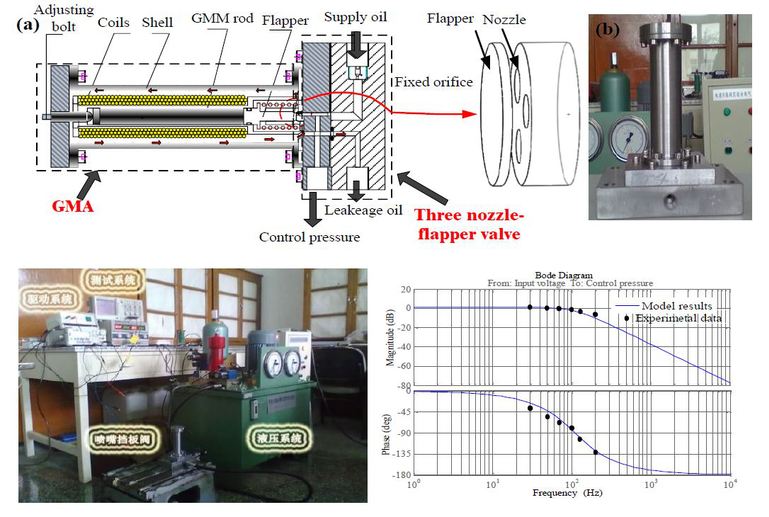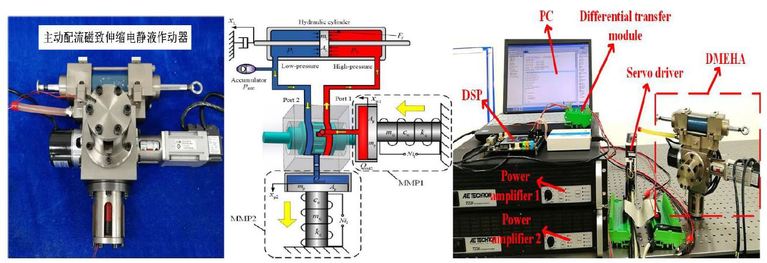
No.1 Research direction: Advanced electro-hydraulic servo valve technology
(1) Technical background
Electro-hydraulic servo valves are widely used in aerospace applications such as modern aircraft maneuvering, aircraft simulation and rocket attitude control. Their bandwidth and flow rate have always been the main factors restricting their performance, but the core technology involved in high-frequency and large-flow electro-hydraulic servo valves It has been difficult to break through, and how to break through its key technology is a problem for China's hydraulic servo academics and aerospace research institutions. The intelligent material-driven actuator represented by the Giant Magnetostrictive Actuator (GMA) provides new opportunities for the development of this technology due to its large output force, high frequency response and high power density. At the same time, however, the hysteresis nonlinearity of the actuator material itself, the influence of eddy current heat and resistance heat, and the nonlinear model and parameter design theory of the electro-hydraulic servo valve have yet to be improved, which poses new challenges for the development of the technology. The laboratory group focuses on the GMA hysteresis nonlinear model research, and focuses on GMA sensing and control technology research; develops GMA heat source calculation, heat transfer and thermal suppression theory and technology; establishes jet-type electro-hydraulic servo valve jet amplification theory The model and the parameter design theory of the nozzle baffle type electro-hydraulic servo valve are improved.
(2) Magnetostrictive jet servo valve technology
In 2009, the laboratory first proposed the new principle of magnetostrictive-driven direct-drive jet servo valve at home and abroad, and pioneered the basic research of high-frequency electro-hydraulic conversion key component-magnetostrictive jet servo valve. The new structure of magnetostrictive force motor direct-drive jet servo valve realizes the integrated design of electro-mechanical conversion and jet amplifier. The modeling theory method of jet equivalent-throttle liquid resistance combined with momentum is proposed for the first time. The mapping rule between the key parameters of the jet servo valve and the performance of the servo valve improves the limitations of the conventional jet-valve valve-dependent parameter design method: the hysteresis nonlinearity of the new giant magnetostrictive actuator based on complex permeability is established. The model is applied to the inverse compensation and closed-loop control of the actuator. The model has the characteristics of less parameters to be identified and easy to implement.
u Valve-specific drive power supply characteristics: Developed a high-frequency drive constant current power supply for super magnetostrictive servo valves. Its output current is -2A~2A, linearity is 3.3%. Under rated output current, the adjustment time is less than 0.5ms. The bandwidth is 2 kHz, and the phase bandwidth is greater than 1 kHZ;
u Jet servo valve response speed: When the oil supply pressure is 7MPa, the rated pressure step rise time is 3ms and the bandwidth is 150Hz under the rated control current; at 25% control current, the output pressure is step rise time is 1.08ms, frequency Width close to 400Hz;
u Jet servo valve control accuracy: A new method of combined active and passive control of servo valve spool is proposed. The servo valve has a thermal displacement control accuracy of less than 3 microns for 600 minutes.

Figure 1 Magnetostrictive jet electro-hydraulic servo valve
(3) Magnetostrictive nozzle baffle servo valve technology
In 2011, the laboratory carried out research on electro-hydraulic servo nozzle of magnetostrictive drive nozzle, and proposed a new parameter design theory and criterion different from the traditional nozzle flapper valve based on maximum pressure sensitivity. The new criterion can be based on nozzle baffle. The comprehensive characteristics of the valve are optimal or the valve structure parameters are optimally designed based on a certain characteristic of the valve. The comparison between the old and new standards shows that the proposed new standard can further improve the key characteristics of the valve linearity, response speed and reliability; The theoretical model of heat source, heat transfer and thermal suppression of magnetostrictive actuators provides guarantee for high-precision actuator design, and provides theoretical and technical support for high-precision spool control of electro-hydraulic servo valves.
u Magnetostrictive nozzle baffle servo valve control pressure: a new structure of magnetostrictive three-nozzle baffle servo valve is proposed. The test and numerical calculation results show that the maximum control pressure is greater than 1 MPa when the oil supply pressure is 7 MPa.
u Magnetostrictive nozzle baffle servo valve response speed: magnetostrictive nozzle baffle servo valve step response rise time is less than 2.5ms; amplitude bandwidth is greater than 150Hz, phase bandwidth is greater than 110Hz;
u Magnetostrictive nozzle baffle servo valve design and analysis software: The rapid design and performance analysis of the key parameters such as the magnetostrictive nozzle baffle servo valve nozzle diameter, fixed orifice diameter and magnetostrictive rod diameter and rod length are realized.

Figure 2 Magnetostrictive nozzle baffle electro-hydraulic servo valve
No.2 Research direction: New principle electrohydrostatic actuator technology
In the 1990s, the US Air Force first proposed the concept of multi-electric aircraft. As an important actuator for the future multi-electric aircraft, the main advantage of the power transmission system is reflected in the implementation of the aircraft's secondary energy system. The transmission between the mechanisms in the form of electrical signals through the wires replaces the traditional onboard hydraulic system of the hydraulic system piping and accessories throughout the whole machine, greatly improving the controllability, safety and energy transmission efficiency of the aircraft, intelligent material drive. As an implementation form of a new type of electrohydrostatic actuator, the electrohydrostatic actuator has the advantages of simple structure, high frequency drive and high resolution displacement output, and has become a research hotspot at home and abroad, mainly through high frequency of smart materials. Vibration combined with fluid rectification technology to realize electro-magnetic-machine-liquid energy conversion, transmission and control, but at the same time, multi-physics coupling and energy conversion laws of intelligent materials and fluid drive control are not clear; inertia load is large, oil Scientific and technical difficulties in terms of compressibility and high-frequency energy loss of smart materials themselves, so for smart materials The driven electrohydrostatic actuators can be applied in engineering practice and require continuous scientific exploration and technical research.
(2) Magnetostrictive electrostatic liquid actuator technology
The laboratory has carried out research on magnetostrictive electro-mechanical actuators and electro-hydraulic actuators since 2014. The magnetostrictive actuators developed have large output force, high energy density, high reliability, high resolution and frequency. The advantages of bandwidth and fast response speed have been developed. Passive distribution and active distribution magnetostrictive direct drive pumps and electrohydrostatic actuators have been developed. The magnetostrictive actuators developed are highly integrated with electro-magnetic-liquid-machine structures. It is characterized by light weight, strong anti-pollution ability and simple structure.
u Magnetostrictive actuator characteristics: When the control current changes from -1A to 1A, the output displacement of the magnetostrictive actuator is about -25μm~25μm, the output step displacement per unit current step is 20.2μm, and the rise time is about 3ms. The time is about 6ms; the unit current output force is greater than 1000N;
u Magnetostrictive hydraulic pump characteristics: the best excitation frequency is 275Hz, the maximum output flow is greater than 1.2L/min, and the maximum working pressure is 2MPa;
u Magnetostrictive actuating storage characteristics: At an excitation frequency of 275 Hz, the actuator takes a large output speed of 50 mm/s; the output of the force is up to 500 N.

Figure 3 Active distribution magnetostrictive electrohydrostatic actuator
(3) Piezoelectric stack electrohydrostatic actuator technology
Since 2016, the laboratory has carried out research on piezoelectric stack-electromechanical actuators and electro-hydraulic actuators. The piezoelectric stack actuators have large output force, high energy density, high reliability and high resolution. The advantages of frequency bandwidth and fast response speed have been developed. Passive distribution unidirectional actuator and bidirectional closed-loop servo control piezoelectric stack actuator have been developed. The piezoelectric stack actuator developed has compact structure and load capacity. Strong and other remarkable features.
u Piezoelectric stack actuator characteristics: the control voltage is changed from 0Vpp to 150Vpp, the piezoelectric stack actuator output displacement is about 0~50μm; the input voltage is 100V step signal, the actuator output blocking force is 1400N, and the response time is about 0.5ms.
u Piezoelectric hydraulic pump characteristics: the best excitation frequency is 275Hz, the maximum output flow is greater than 1.6L/min, and the maximum working pressure is 2MPa;
u Piezoelectric stack actuator characteristics: The piezoelectric stack actuator has an input voltage of 140Vpp at an excitation frequency of 275Hz, an actuator maximum output flow of more than 1.6L/mn, and a maximum output force of 600N.

Figure 4 passive distribution of piezoelectric stack driven electrohydrostatic actuator
No.3 Research direction: Intelligent digital hydraulic components and systems
(1) Technical background
As an emerging branch of flow control technology, digital hydraulic technology has significant advantages in promoting the innovation of flow control technology. Compared with traditional electric proportional and electro-hydraulic servo valve control systems, digital hydraulic system has high efficiency, good control flexibility and reliability. Higher advantages, it is becoming one of the most competitive alternatives to traditional valve control systems. The digital hydraulic system realizes intelligent monitoring and fault diagnosis through software, and has the functions of “digital” and “plug and play”, which meets the requirements of Industry 4.0. As a kind of digital valve, high-speed on-off valve has the characteristics of anti-pollution, good repeatability and non-linear phenomenon, which has little influence on the digital valve control system. It is widely used in automotive fuel injection and shock absorption, automotive and aircraft brakes, etc. The Pulse Width Modulation (PWM) digital signal is driven to discretize the flow by adjusting the duty cycle of the PWM signal. The digitally-switched Inertial Hydraulic Converter (SIHC) is a typical representative of digital hydraulic systems. Its system consists mainly of high-speed switching valves, inertial tubes and accumulators. The basic principle lies in the formation and utilization of fluid inertia effects. By combining digital switching technology with fluid inertia effect, it has the potential to have 100% working efficiency under the premise of ignoring friction and high-speed switching valve port loss and leakage.
(2) High-speed on-off valve technology
Since 2017, the laboratory has carried out research on magnetostrictive drive high-frequency on-off valve. The developed high-frequency on-off valve has the advantages of fast response speed, large linear range and large flow capacity. It has developed a magnetostrictive direct drive type. Frequency switching valve, magnetostrictive hydraulic amplification type high frequency switching valve and electromagnetic two-stage high-flow high-frequency switching valve.

Figure 5 magnetostrictive high frequency switching valve
The laboratory has carried out research on low-power electromagnetic high-frequency on-off valve since 2018. Based on the nonlinear sliding mode observer, the spool displacement is estimated in real time to ensure the valve core is fully opened. The high-frequency PWM duty is controlled based on the real-time feedback of the oil supply pressure. Ratio, the minimum holding current is achieved; the reverse PWM duty cycle is controlled based on the coil current real-time feedback to accelerate the current unloading.

Figure 6 low-power electromagnetic high-frequency switching valve
(3) Digital parallel hydraulic technology
The laboratory has carried out research on digital parallel flow control unit (DFCU) since 2018. For the micro-positioning problem of parallel digital valve control system under PNM (equal coding) control, a speed segmentation method is proposed. The control strategy, the positioning error can be controlled within 0.05mm. Aiming at the problem that the switching frequency of the equivalent-coded DFCU is large under the control of PNM and differential PWM, an equal-switching control strategy based on the cyclic sliding method is proposed. The uniformity of switching valve switching times is improved by about 62.7%.

Figure 7 digital parallel array hydraulic control
(4) Digital inertial hydraulic technology
The laboratory has carried out research on the digital switch inertia hydraulic converter since 2019. The design of the high-speed on-off valve control cylinder hydraulic system principle is shown in Figure 8. It is mainly composed of hydraulic pump 1, overflow valve 2, two-way high-speed The switch valve 3, the inertia tube 4, the electromagnetic reversing valve 5, the single-acting hydraulic cylinder 6 and the like are composed.

Figure 8 high efficiency digital inertial hydraulic system